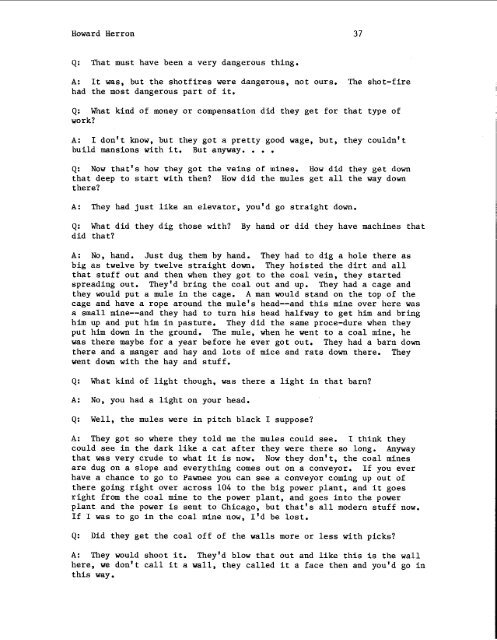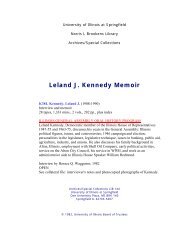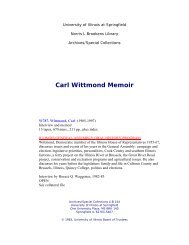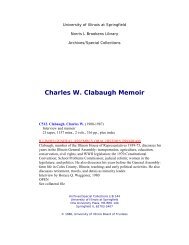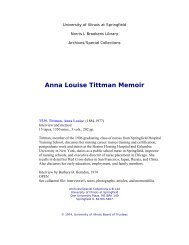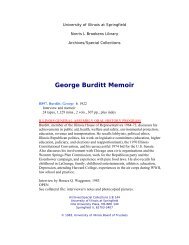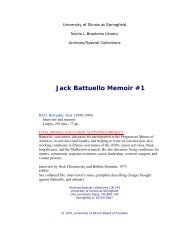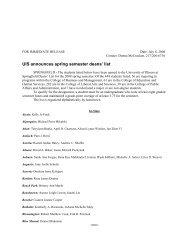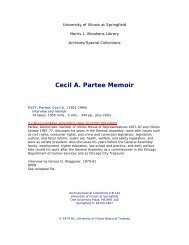Howard Herron Memoir - University of Illinois Springfield
Howard Herron Memoir - University of Illinois Springfield
Howard Herron Memoir - University of Illinois Springfield
Create successful ePaper yourself
Turn your PDF publications into a flip-book with our unique Google optimized e-Paper software.
<strong>Howard</strong> <strong>Herron</strong> 3 7<br />
Q: That must have been a very dangerous thing.<br />
A: It was, but the shotfires were dangerous, not ours. The shot-fire<br />
had the most dangerous part <strong>of</strong> it.<br />
Q: What kind <strong>of</strong> money or compensation did they get for that type <strong>of</strong><br />
work?<br />
A: I don't know, but they got a pretty good wage, but, they couldn't<br />
build mansions with it. But anyway. . . .<br />
Q: Now that's how they got the veins <strong>of</strong> mines. How did they get down<br />
that deep to start with then? How did the mules get all the way down<br />
there?<br />
A: They had just like an elevator, you'd go straight down.<br />
Q: What did they dig those with? By hand or did they have machines that<br />
did that?<br />
A: No, hand, Just dug them by hand. They had to dig a hole there as<br />
big as twelve by twelve straight down. They hoisted the dirt and all<br />
that stuff out and then when they got to the coal vein, they started<br />
spreading out. They'd bring the coal out and up. They had a cage and<br />
they would put a mule in the cage. A man would stand on the top <strong>of</strong> the<br />
cage and have a rope around the mule's head--and this mine over here was<br />
a small mine--and they had to turn his head halfway to get him and bring<br />
him up and put him in pasture. They did the same proce-dure when they<br />
put him down in the ground. The mule, when he went to a coal mine, he<br />
was there maybe for a year before he ever got out. They had a barn down<br />
there and a manger and hay and lots <strong>of</strong> mice and rats down there. They<br />
went down with the hay and stuff.<br />
Q: What kind <strong>of</strong> light though, was there a light in that barn?<br />
A: No, you had a light on your head.<br />
Q: Well, the mules were in pitch black I suppose?<br />
A: They got so where they told me the mules could see. I think they<br />
could see in the dark like a cat after they were there so long. Anyway<br />
that was very crude to what it is now. Now they don't, the coal mines<br />
are dug on a slope and everything comes out on a conveyor. If you ever<br />
have a chance to go to Pawnee you can see a conveyor coming up out <strong>of</strong><br />
there going right over across 104 to the big power plant, and it goes<br />
right from the coal mine to the power plant, and goes into the power<br />
plant and the power is sent to Chicago, but that's all modern stuff now.<br />
If I was to go in the coal mine now, I'd be lost.<br />
Q: Did they get the coal <strong>of</strong>f <strong>of</strong> the walls more or less with picks?<br />
A: They would shoot it. They'd blow that out and like this is the wall<br />
here, we don't call it a wall, they called it a face then and you'd go in<br />
this way.


